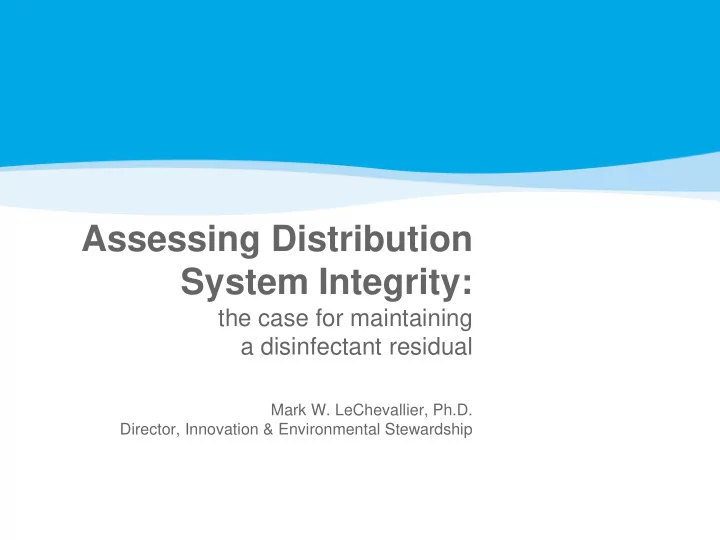

Assessing Distribution System Integrity: the case for maintaining a disinfectant residual Mark W. LeChevallier, Ph.D. Director, Innovation & Environmental Stewardship
Regulation of Disinfection in the US Surface Water Treatment Rule Giardia and Virus CT values Maintenance of disinfectant residual at 95% locations Long Term II Enhanced Surface Water Treatment Rule Cryptosporidium Groundwater Rule Viruses Stage 1 Disinfection/Disinfection By-Product Rule maximum residual limit (based on an annual average) of 4 mg/L for free chlorine and chloramines Total Coliform Rule Disinfectant residual monitoring locations 2
Water Treatment: the Multiple Barrier Concept • Source Water Protection Surface Water Groundwater • Filtration • Disinfection • Distribution System Chlorine residual Pressurized networks Cross connection control 3
Dead-End Free Chlorine Residual # % Avg/100 Residual N #Samples # Positive Colonies Positive mL mg/L 0 - 0.2 99 11,056 138 10,535 1.248 0.953 0.2 - 0.5 159 10,637 36 2,850 0.338 0.267 0.5 - 1.0 164 14,276 87 2,107 0.609 0.147 > 1.0 127 7,803 118 4,955 1.512 0.635 4 LeChevallier et al., 1996. Appl. Environ. Microbiol. 62(7): 2201-2211.
Dead-End Chloramine Residual # % Avg/100 Residual N #Samples # Positive Colonies Positive mL mg/L 0 - 0.5 110 11,447 67 331 0.585 0.029 0.5 - 1.0 125 7,106 20 66 0.281 0.009 1.0 - 2.0 121 7,564 13 15 0.171 0.001 > 2.0 105 9,835 83 213 0.844 0.022 LeChevallier et al., 1996. Appl. Environ. Microbiol. 62(7): 2201-2211. 5
Impact of Pipe Surface on Disinfection of Biofilm Bacteria Decrease Log Viable Count (CFU/cm²) 7 Free 1 mg/L 6 Mono 1 mg/L Free 4 mg/L 5 Mono 4 mg/L 4 3 2 1 0 Iron Galvanized Copper PVC LeChevallier, Lowry, and Lee. 1990. J. Amer. Water Works Assoc. 82(7): 87-99. 6
7
Model for Monochloramine Disinfection of Biofilm Bacteria Standard t- Significance Coefficient Error Statistic Level Log reduction viable counts= Intercept -1.0734 0.5685 -1.888 0.0816 Log Larson Index -0.5808 0.l963 -2.958 0.0111 Log Corrosion Rate -0.4820 0.3205 -1.504 0.1566 Log Monochloramine 2.0086 0.9226 2.177 0.0485 Phosphate Level 0.1445 0.0336 4.295 0.0009 Corrected R-Squared: 0.746 F test: 13.474 Model is based on 18 observations LeChevallier, Lowry, and Lee. 1990. J. Amer. Water Works Assoc. 82(7): 87-99. 8
Nosocomial Legionnaires’ Disease Kool et al ., Lancet 353: 272-277 1999 Examined 32 nosocomial outbreaks, 1979-1997, in which drinking water was implicated Examined characteristics of the hospital (size, transplant program), primary disinfectant treatment, disinfectant residual, water source, community size, pH. Odds of nosocomial outbreak was 10.2 (1.4-460) higher in systems that maintained free chlorine versus a chloramine residual. Estimated that 90% of outbreaks could be prevented if chloramines were universally sed. 9
Nosocomial Legionnaires’ Disease International Conference on Nosocomial Infections (www.decennial.org): Survey 166 hospitals. Those supplied with chloraminated water were less likely (RR=0.36, CI=0.18-0.72) to have nosocomial Legionnaires disease. International Legionella Conference (www.uni-ulm.de): Monochloramine at 1.5 mg/L resulted in >99.9% inactivation of Legionella biofilms within 60 min. Association for Professionals in Infectious Control (www.apic.org): Fed chloramines to a hospital. Legionella were 97.9 cfu/mL before (n=72), and 0.13 cfu/mL after (n=104) treatment with 0.1 mg/L chloramines. 10
Lessons from Real Life: San Francisco, CA • 53 buildings • Sampled 3 times pre- and post-conversion to chloramines • Sampled hot water heater and four distal sites • Sampled swab and water from distal sites • Surveys collected data on building age, height, type and number of hot water heaters • pH, temperature, free or total Cl 2 residual measured for each sample Flannery, B. et al. 2006. Reducing Legionella colonization of water systems with monochloramine. Emerg. Infect. Dis. 12(4): 588-596. http://www.cdc.gov/ncidod/EID/vol12no04/05-1101.htm. 11
Round 1 Round 2 Round 3 Round 4 Round 5 Round 6 Heater #2 #3 #4 #5 #6 #7 #8 #9 Heater #2 #3 #4 #5 #6 #7 #8 #9 Heater #2 #3 #4 #5 #6 #7 #8 #9 Heater #2 #3 #4 #5 #6 #7 #8 #9 Heater #2 #3 #4 #5 #6 #7 #8 #9 Heater #2 #3 #4 #5 #6 #7 #8 #9 12
Legionella and Amoebae • Intracellular Legionella in: Acanthamoeba, Amoeba, Comandonia, Echinamoeba, Filamoeba, Hartmannella, Naegleria, Paratetramitus, Vahlkamfia, Tetrahymena, Dictyostelium • Legionella survive for months, resistant to 50 mg/L Trophozoite free chlorine for 18 hr • Coated with amoebal proteins • Increases virulence, replication • Legionella- containing vacuoles expelled prior to Cyst encystation • Trophozoite stage sensitive to disinfectants (CT 99.9 = 1.5 mg-min/L) 13
Trophozoite Concentration Trophs Trophs Utility 25 C 42 C TX - #27 74 82 FL - #30 59 73 CA - #4 68 73 FL - #31 36 60 CA - #32 13 36 AZ - #33 58 84 Chloramines 14
Disinfectant Residual Performance Assessment Performance Goals: Chlorine residual 95% > 0.2mg/L free chlorine or > 0.5 mg/L total chlorine (chloramine systems) Chlorine residual may not be undetectable for two consecutive months Monitoring based on a representative system wide plan consisting of key sites and compliance sites: Stage 1 & 2 DBP sites, TCR and tank sites and all pressure zones The minimum number of sites should be population based Monthly minimum monitoring Sample taps flushed to be representative of water in the main Testing conducted using colorimeter or online monitor Friedman, M., G. Kirmeyer, J. Lemieux, M. LeChevallier, S. Seidl, and J. Routt . 2010. Criteria for Optimized Distribution Systems. Water Research Foundation, Denver, CO. 15
16
Accuracy of Disinfectant Residual Measurement • Important to consider measurement variation • If the true target is 0.2 mg/L, and measurements have 0. mg/L variation, then utilities must maintain 0.3 mg/L to ensure compliance • Most systems will utilize an 80% safety factor • Therefore systems will target 0.4-0.5 mg/L for compliance 17
Recommend
More recommend